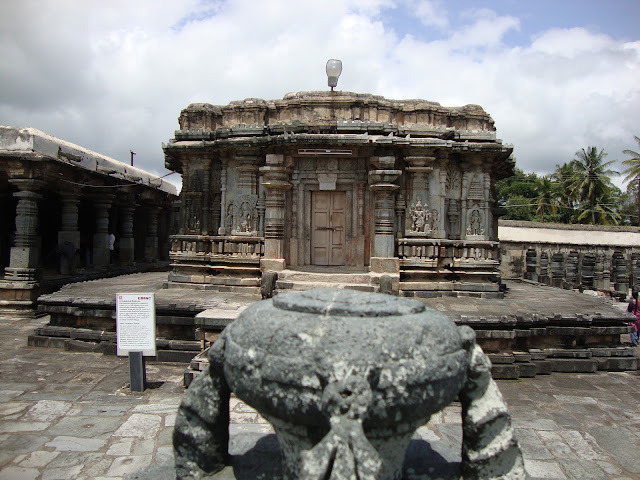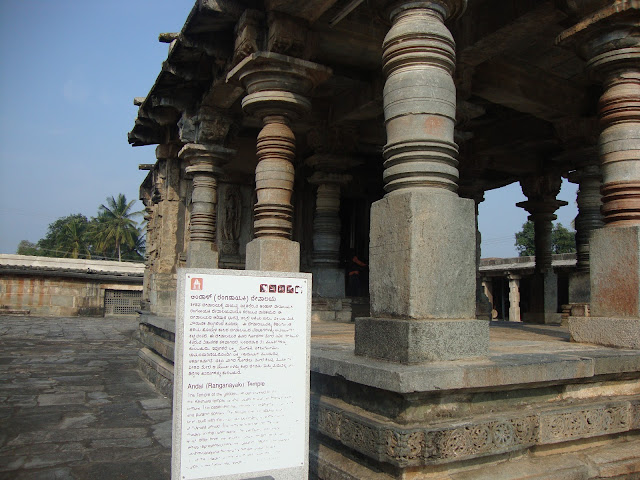The Chennakesava Temple originally called Vijayanarayana Temple , was built on the banks of the Yagachi River in Belur, by the Hoysala Empire King Vishnuvardhana.
The temple was commissioned by King Vishnuvardhana in 1117 AD. Scholars are divided about the reasons for the construction of the temple. The military successes of Vishnuvardhana is considered a probable reason. Some scholars believe Vishnuvardhana commissioned the temple to surpass his overlord, King Vikramaditya VI of the Western Chalukya Empire (who ruled from Basavakalyan), after his initial military victories against the Chalukyas.According to another theory, Vishnuvardhana was celebrating his famous victory against the Chola dynasty of Tamil country in the battle of Talakad (1116 AD.), which resulted in the annexation of Gangavadi (modern southern Karnataka) by the Hoysalas. Another theory points to Vishnuvardhana's conversion from Jainism to Vaishnavism (a sect of Hinduism) after coming under the influence of saint Ramanujacharya, considering this is a predominantly Vaishnava temple in sculptural iconography.The Hoysalas employed many noted architects and artisans who developed a new architectural tradition, which art critic Adam Hardy called the Karnata Dravida tradition.In all 118 inscriptions have been recovered from the temple complex, covering the period 1117 CE to the 18th century, giving historians details of the artists employed, grants made to the temple and renovations committed during later times.
The building material used in the Chennakesava temple is chloritic schist, more commonly known as (soapstone) or potstone, and is essentially a simple Hoysala plan built with extraordinary detail. What differentiates this temple from other Hoysala temples of the same plan is the unusually large size of the basic parts of the temple. The temple is a ekakuta vimana design (single shrine) of 10.5 m by 10.5 m size. A large vestibule connects the shrine to the mandapa (hall) which is one of the main attractions of the temple. The mandapa has 60 "bays" (compartments). The superstructure (tower or Sikhara) on top of the vimana has been lost over time. The temple is built on a jagati (platform for circumabulation). There is one flight of steps leading to the jagati and another flight of steps to the mantapa. The jagati provides the devotee the opportunity to do a pradakshina (circumambulation) around the temple before entering it. The jagati carefully follows the staggered square design of the mantapa and the star shape of the shrine. The mantapa here was originally an open one. A visitor would have been able to see the ornate pillars of the open mantapa from the platform. According to art critic Gerard Foekema, the mantapa is perhaps the most magnificent one in all of medieval India. The open mantapa was converted into a closed one after about fifty years, during the Hoysala rule. This was done by erecting walls with pierced window screens. The window screens are on top of 2 m high walls. There are twenty eight such windows, with star-shaped perforations and bands of foliage, figures and mythological subjects. On one such screen, King Vishnuvardhana and his queen Shanatala Devi are depicted. Another icon depicts the king in a standing posture.
The vimana (shrine) is at the back of the mantapa. Each side of the vimana measures 10.5 m and has five vertical sections. Each vertical section comprises a large double storeyed niche in the centre and two heavy pillar like sections on either side. The two pillar-like sections adjoining the niche are rotated about their vertical axis to produce a star-shaped plan for the shrine. The pillar-like section and the niche bear many ornate sculptures, belonging to an earlier style. There are some sixty large sculptures of deities from both Vaishnava and Shaiva faiths. From the shape of the vimana it has been inferred that the tower above it would have been of the Bhumija style when it existed and not the regular star shaped tower that followed the shape of the vimana. The Bhumija towers, which are intact on the miniature shrines at the entrance of the hall are actually a type of nagara (North Indian) tower, being curvilinear in shape. This shape of tower is quite uncommon in pure dravidian architecture. The shrine has a life size (about 6 ft) image of Kesava (a form of Vishnu) with four hands. Each hand holds an attribute; the discus (chakra), the mace (gadha), the lotus-flower (padma) and the conch (Shanka), in clockwise direction. The entrance to the shrine is flanked by life size sculptures of door guardians (dvarapalaka).
The pillars inside the hall are an attraction and the most popular one is the Narasimha pillar which at one time could have revolved on its ball bearings. According to the historian Kamath, there is a rich diversity about the pillar styles here. While all the forty eight pillars are unique and the many ceiling sections are well decorated, nothing surpasses the finish of the four central pillars and the ceiling they support. These pillars may have been hand chiseled while the others were lathe turned. All of these four pillars bear madanikas (Salabhanjika–celestial damsels). There are 42 of them in the temple complex, one each on the four central pillars inside the hall and the remaining 38 are outside, between the eaves on the outer walls of the hall.They are also called shilabalika and represent the ideal female form. They are depicted in various forms, such as dancers, musicians and drummers, and are rarely erotic in nature. Some madanikas that usually are popular with tourists are the Darpana Sundari (lit,"beauty with mirror"), "The lady with the parrot", "The huntress" and Bhasma mohini. Other interesting sculptures inside the mantapa are Sthamba buttalika (pillar with an image in frieze) which is more in the Chola style indicating that the Hoysalas may have employed Chola craftsman along with locals. These images have less decor than regular Hoysala sculptures, the mohini pillar being an example.At the base of the outer walls are friezesof charging elephants (six hundred and fifty of them) which symbolize stability and strength, above which are lions which symbolize courage, and further up are horses which symbolize speed. Above the horses are panels with floral designs signifying beauty above which are sculptures with depictions from the Hindu epics, the Ramayana and the Mahabharata. According to Kamath, this style of articulation is called horizontal treatment with friezes. Hoysala artisans preferred to be discreet about eroticism, mingling miniature erotic sculptures in not so conspicuous places such as recesses and niches. Sculptures depict daily life in a broad sense.
The doorways to the mantapa have on both sides an image of "Sala" slaying a lion. Historian Kamath claims this is a tiger. Though Sala is known to be the founder of the Hoysala empire in popular legend, there is no support for this theory from scholars such as D.M. Durrett, B.R. Joshi and Hayavadhana Rao. Normally this image is placed on the sukanasi (tower over the vestibule) adjoining the main tower. Legend has it that Sala killed the lion (or tiger) which was about to pounce on a meditating saint who sought Sala's help. Some historians speculate that the legend may have gained importance after King Vishnuvardhana's victory over the Chola dynasty in the battle of Talakad, the tiger being the royal emblem of the Cholas.
Other important sculptures here are the Narasimha (a form of Vishnu) image in the south western corner, Gajasurasamhara (Hindu god Shiva slaying demon in form of elephant) on the western side, the winged Garuda, a consort of the god Vishnu standing facing the temple, dancing Kali (a form of Durga), a seated Ganesha (son of Shiva), a boy with an umbrella and a king (the Vamana Avatar or incarnation of Vishnu), Ravana shaking Mount Kailash, Durga slaying demon Mahishasura, standing Brahma, Varaha (avatar of Vishnu), Shiva dancing on demon (Andhakasura), Bhairava (avatar of Shiva), Pandava prince Arjuna shooting a fish seeing its reflection, and the Sun god Surya. The sculptural style of the wall images bear similarities with wall sculptures in contemporary temples of northern Karnataka and adjacent Maharashtra.
The Hoysala artists, unlike other medieval artists, preferred to sign their work in the form of inscriptions. In doing so, they sometimes revealed fascinating details about themselves, their families, guilds and place of origin.Stone inscriptions and copper plate inscriptions provide more information about them. Ruvari Mallitamma was a prolific artist to whom more than 40 sculptures are attributed.Dasoja and his son Chavana who were from Balligavi in modern Shimoga district made important contributions. Chavana is credited with the work on five madanikas and Dasoja accomplished four of them. Malliyanna and Nagoja created birds and animals in their sculptures. Artists such as Chikkahampa and Malloja are credited with some of the sculptures in the mantapa



































































No comments:
Post a Comment